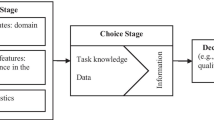Abstract
The performance of most operations systems is significantly affected by the interaction of human decision-makers. A methodology, based on the use of visual interactive simulation (VIS) and artificial intelligence (AI), is described that aims to identify and improve human decision-making in operations systems. The methodology, known as ‘knowledge-based improvement’ (KBI), elicits knowledge from a decision-maker via a VIS and then uses AI methods to represent decision-making. By linking the VIS and AI representation, it is possible to predict the performance of the operations system under different decision-making strategies and to search for improved strategies. The KBI methodology is applied to the decision-making surrounding unplanned maintenance operations at a Ford Motor Company engine assembly plant.




Similar content being viewed by others
References
Baines TS and Kay JM (2002). Human performance modelling as an aid in the process of manufacturing system design: a pilot study. Int J Prod Res 40(10): 2321–2334.
Doukidis GI and Angelides MC (1994). A framework for integrating artificial intelligence and simulation. Artif Intell Rev 8(1): 55–85.
Doukidis G and Paul R (1985). Research into expert systems to aid simulation model formulation. J Opl Res Soc 36(4): 319–325.
Hurrion RD (1993). Representing and learning distributions with the aid of a neural network. J Opl Res Soc 44(10): 1013–1024.
Balmer D and Paul RJ (1986). CASM—the right environment for simulation. J Opl Res Soc 37(5): 443–452.
Mathewson S (1989). Simulation support environments. In: Pidd M (ed). Computer Modelling for Discrete Simulation. Wiley: Chichester, pp 57–100.
Doukidis GI (1987). An anthology on the homology of simulation with artificial intelligence. J Opl Res Soc 38(8): 701–712.
Deslanders V and Pierreval H (1991). An expert system prototype assisting the statistical validation of simulation models. Simulation 56(2): 79–89.
Hurrion RD (1991). Intelligent visual interactive modeling. Eur J Opl Res 54(3): 349–356.
Hurrion RD (1992). Using a neural network to enhance the decision making quality of a visual interactive simulation model. J Opl Res Soc 43(4): 333–342.
Hurrion RD (1993). Using 3D animation techniques to help with the experimental design and analysis phase of a visual interactive simulation project. J Opl Res Soc 44(7): 693–700.
Hurrion RD (2000). A sequential method for the development of visual interactive meta-simulation models using neural networks. J Opl Res Soc 51(6): 712–719.
Hurrion RD (1997). An example of simulation optimisation using a neural network metamodel: finding the optimum number of kanbans in a manufacturing system. J Opl Res Soc 48(11): 1105–1112.
Pierreval H (1992). Expert systems for selecting priority rules in flexible manufacturing systems. Expert Systems Appl 5: 51–57.
Flitman AM and Hurrion RD (1987). Linking discrete-event simulation models with expert systems. J Opl Res Soc 38(8): 723–734.
O'Keefe RM (1989). The role of artificial intelligence in discrete-event simulation. In: Widman LE, Loparo KA and Neilsen NR (eds). Artificial Intelligence, Simulation and Modeling. Wiley: New York, pp 359–379.
Williams T (1996). Simulating the man-in-the-loop. OR Insight 9(4): 17–21.
Lyu J and Gunasekaran A (1997). An intelligent simulation model to evaluate scheduling strategies in a steel company. Int J Systems Sci 28(6): 611–616.
Moffat J (2000). Representing the command and control process in simulation models of conflict. J Opl Res Soc 51(4): 431–439.
Kidd AL (1987). Knowledge Acquisition for Expert Systems: a Practical Handbook. Plenum: New York.
Pidd M (2003). Tools for Thinking: Modelling in Management Science. Wiley: Chichester, UK.
Robinson S (1994). Successful Simulation: a Practical Approach to Simulation Projects. McGraw Hill: Maidenhead, UK.
Mingers J (1986). Expert systems—experiments with rule induction. J Opl Res Soc 37(11): 1031–1086.
Robinson S, Edwards JS and Yongfa W (2003). Linking the witness simulation software to an expert system to represent a decision-making process. J Comput Inf Technol 11(2): 123–133.
Lanner Group (2003). Witness2003. Lanner Group: Redditch, UK.
Polanyi M (1966). The tacit dimension. Doubleday: Garden City, NY.
Bigus JP (1996). Data Mining with Neural Networks: Solving Business Problems—From Application Development to Decision Support. McGraw-Hill: New York, London.
Pampel FC (2000). Logistic Regression: a Primer. Sage Publications: London.
Mingers J (1987). Expert systems—rule induction with statistical data. J Opl Res Soc 38(1): 39–47.
Breiman L, Friedman JH, Olshen RA and Stone CJ (1984). Classification and Regression Trees. Wadsworth: Belmont, CA.
Attar Software (2000). XpertRule KBS Reference Manual. Attar Software: Leigh, UK.
Law AM and Kelton WD (2000). Simulation Modeling and Analysis, 3rd edn. McGraw Hill: New York.
Fishman GS (1978). Grouping observations in digital simulation. Mngt Sci 24(5): 510–521.
Acknowledgements
This work was jointly funded by the EPSRC (Grant reference GR/M72876), Ford Motor Company and the Lanner Group.
Author information
Authors and Affiliations
Corresponding author
Rights and permissions
About this article
Cite this article
Robinson, S., Alifantis, T., Edwards, J. et al. Knowledge-based improvement: simulation and artificial intelligence for identifying and improving human decision-making in an operations system. J Oper Res Soc 56, 912–921 (2005). https://doi.org/10.1057/palgrave.jors.2601915
Received:
Accepted:
Published:
Issue Date:
DOI: https://doi.org/10.1057/palgrave.jors.2601915




